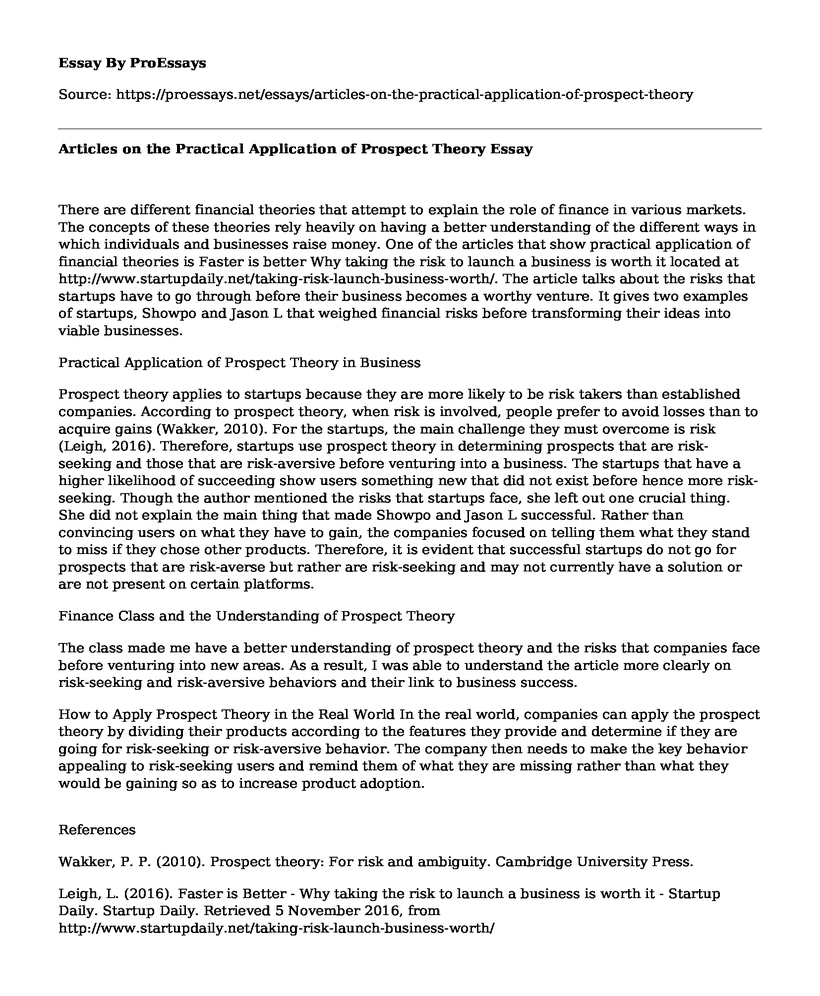There are different financial theories that attempt to explain the role of finance in various markets. The concepts of these theories rely heavily on having a better understanding of the different ways in which individuals and businesses raise money. One of the articles that show practical application of financial theories is Faster is better Why taking the risk to launch a business is worth it located at http://www.startupdaily.net/taking-risk-launch-business-worth/. The article talks about the risks that startups have to go through before their business becomes a worthy venture. It gives two examples of startups, Showpo and Jason L that weighed financial risks before transforming their ideas into viable businesses.
Practical Application of Prospect Theory in Business
Prospect theory applies to startups because they are more likely to be risk takers than established companies. According to prospect theory, when risk is involved, people prefer to avoid losses than to acquire gains (Wakker, 2010). For the startups, the main challenge they must overcome is risk (Leigh, 2016). Therefore, startups use prospect theory in determining prospects that are risk-seeking and those that are risk-aversive before venturing into a business. The startups that have a higher likelihood of succeeding show users something new that did not exist before hence more risk-seeking. Though the author mentioned the risks that startups face, she left out one crucial thing. She did not explain the main thing that made Showpo and Jason L successful. Rather than convincing users on what they have to gain, the companies focused on telling them what they stand to miss if they chose other products. Therefore, it is evident that successful startups do not go for prospects that are risk-averse but rather are risk-seeking and may not currently have a solution or are not present on certain platforms.
Finance Class and the Understanding of Prospect Theory
The class made me have a better understanding of prospect theory and the risks that companies face before venturing into new areas. As a result, I was able to understand the article more clearly on risk-seeking and risk-aversive behaviors and their link to business success.
How to Apply Prospect Theory in the Real World In the real world, companies can apply the prospect theory by dividing their products according to the features they provide and determine if they are going for risk-seeking or risk-aversive behavior. The company then needs to make the key behavior appealing to risk-seeking users and remind them of what they are missing rather than what they would be gaining so as to increase product adoption.
References
Wakker, P. P. (2010). Prospect theory: For risk and ambiguity. Cambridge University Press.
Leigh, L. (2016). Faster is Better - Why taking the risk to launch a business is worth it - Startup Daily. Startup Daily. Retrieved 5 November 2016, from http://www.startupdaily.net/taking-risk-launch-business-worth/
Cite this page
Articles on the Practical Application of Prospect Theory. (2021, Mar 25). Retrieved from https://proessays.net/essays/articles-on-the-practical-application-of-prospect-theory
If you are the original author of this essay and no longer wish to have it published on the ProEssays website, please click below to request its removal:
- Research Paper Sample on the Apple vs. Samsung Case
- Essay Example on Law and Ethics in Business Environment
- Imperial Hotel in London Case Study Paper Example
- RoamAbout Hotel: Crafting an Incident Response Plan for Potential Cybersecurity Incidents - Essay Sample
- UK Boutique Hotel Chain Expands to France & Germany - Essay Sample
- Essay Example on Unlock the Secrets of Value Investing: The Money Machine
- Paper Example on Valeant CEOs' Unethical Practices: Price Gouging, Corporate Corruption & More







